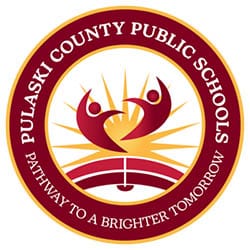Board hears of budget, attendance, discipline
 By WILLIAM PAINE
By WILLIAM PAINE
Patriot Publishing
The Pulaski County School Board recently heard an early analysis on the 2024-25 school budget. They also heard that both attendance and discipline are improving.
Finance Director Morgan Sklar provided the budget analysis based on the Governor’s proposed budget for fiscal year 2024-2025.
Sklar began with revenue aspect of the budget saying that the school systems projected Average Daily Membership (ADM), which refers to the number of students attending school daily, is 4,172. This translates into $40,515,892 in state funding for PCPS. Pulaski County gives $16,580,454 to the school system annually, while Federal funding adds $6,011,067 to the school system’s revenue stream.
Miscellaneous local revenues of $817,037 (refunds and recoveries, tuition payments, local grants, etc.), brings the PCPS total estimated revenue budget to $63,924,449.
After years of decline, the Average Daily Membership in county schools increased this past year. This is a result of an influx in students taking courses online through the Stride K-12 Virtual Academy, which PCPS makes available to students all over the Commonwealth. The projected revenue from the increase in ADM related to the Stride Virtual Academy is $4,724,366, which works out to 5.5 percent in additional revenue for the school system.
On the expenditure side, the administration seeks a 5 percent pay raise for all PCPS employees at a cost of $2,053,520. The administration also recommends hiring both an art and a music teacher for the elementary schools, as well as retaining a third Assistant Principal at Pulaski County Middle School, who was paid through ESSER funding that expires in September.
Lastly, the school system is currently searching for a new health insurance consultant to help navigate what is expected to be up to a 20 percent increase in insurance costs in the coming year. The total estimated cost increase for employee insurance is estimated at $1,472,637 and school administrators would prefer that PCPS employees not have to shoulder the burden of this cost increase.
This brings the total budget expenditure to $64,441,258, which leaves a $516,809 shortfall. However, it is widely expected that the General Assembly will increase the governor’s proposed state funding by the time the state budget is passed.
“It sounds really positive,” said board chairman Josh Taylor. “It could be a lot worse and with the raises, what is that Rob, a 17 percent raise in three years?”
“If we go up to a 6 percent pay raise, which we’ve discussed with the county, that’s about a 19 percent raise over three years, so … that’s a lot,” Superintendent Rob Graham replied.
Superintendent Graham then gave the board an abbreviated attendance report noting that attendance is improved and that all schools, minus the high school, had at least a 94 percent attendance rate.
Board member Sabrina Cox said that she’d met a “mom” who had put together a word document with students explaining in their own words, why they don’t come to school.
Superintendent Graham said he’d love to see that and Cox agreed to meet later to discuss the issue.
Graham also mentioned that discipline was improving.
Board member Gina Paine asked if this was because students understood that bad behavior will now result in more serious consequences.
“I think so,” said Graham, noting that the administrators now have more autonomy to deal with discipline issues than in the past.
Taylor also mentioned his support for new art and music teachers at the elementary schools.
School board members then heard presentations on the school system’s Special Education and Career and Technical Education programs.
Sarah Polcha, the PCPS Assistant Superintendent of Student Services, gave a detailed presentation focusing on Special Education.
Polcha began by stating that special education services should be provided in the least restrictive setting possible. Polcha noted that there are currently 43 teachers, four coordinators and approximately 60 paraprofessionals working in the special education department.
Polcha then mentioned a 2017 state audit that resulted in a Corrective Action Plan, which was designed to bring the division back in line with state regulations. According to the audit, students with disabilities were found to have been given significantly more out-of-school suspensions than their nondisabled peers. According to Polcha, the Virginia Department of Education has since recognized the efforts made by PCPS to come into compliance with state regulations.
There are currently 698 students enrolled in the PCPS special education program and, as Polcha explained, some of these students cost as much as $100,000 a year in educational services. She then described the complex funding formulas involved in bringing state and federal funds to the school system, as well as the myriad regulations relating to educating these children.
Polcha mentioned how the number of students enrolled in PCPS special education classes had been steadily decreasing since 2017 until this school year, when enrollment jumped 15.5 percent. Critzer Elementary has the largest percentage of students with disabilities attending with seven students with disabilities enrolling in just one week, mostly from out of Pulaski County.
“That’s unheard of,” said Polcha. “Frankly we’re seeing an influx of students with disabilities in the division because of our reputation for special ed… I’ll tell you right now, I’d put my staff up against Montgomery, Giles or Radford any day and we will outdo them when it comes to special education.”
